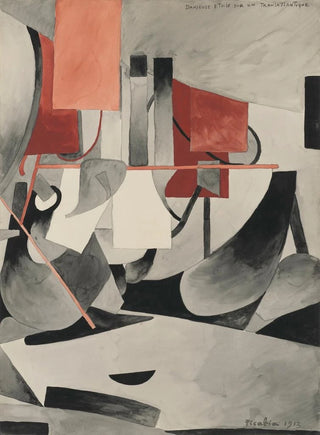Art print | Danseuse canvas on a transatlantic - Francis Picabia


View from behind

Frame (optional)
Captivating Introduction
In the vibrant universe of modern art, some works manage to capture the essence of an era while transcending the limits of time. "Danseuse toile sur un transatlantique - Francis Picabia" falls into this category of iconic artworks. Through this piece, Picabia does not merely depict a dancer but evokes a lively atmosphere, a palpable energy that resonates with the viewer. The canvas, through its composition and aesthetic, immerses us in a world where movement and color meet, revealing the complexities of the emerging modernity at the beginning of the 20th century. The dancer, the central figure of this artwork, thus becomes the symbol of a rapidly changing era, where art and daily life intertwine in unprecedented ways.
Style and uniqueness of the work
Picabia's work stands out for its boldness and ability to challenge the artistic conventions of his time. "Danseuse toile sur un transatlantique" is a perfect illustration of his unique style, blending abstraction and figuration. The flowing lines and dynamic shapes evoke movement, while the vivid colors infuse vitality into the scene. This art print is not limited to a simple representation; it is an exploration of sensations and emotions. Picabia plays with light and shadow, creating striking contrasts that enhance the visual impact of the piece. The dancer, in full motion, almost seems to escape the canvas, as if inviting the viewer into her world. This ability to capture movement and energy is what makes this artwork so singular and timeless.
The artist and his influence
Francis Picabia, an emblematic figure of Dadaism and Surrealism, managed to leave his mark on his era through an innovative approach to art. Born in 1879, he traversed various artistic movements, leaving an indelible imprint on each of them. His work, rich and diverse, testifies to a constant quest for experimentation and renewal. Picabia was always interested in the relationship between art and technology, exploring the

Matte finish

View from behind

Frame (optional)
Captivating Introduction
In the vibrant universe of modern art, some works manage to capture the essence of an era while transcending the limits of time. "Danseuse toile sur un transatlantique - Francis Picabia" falls into this category of iconic artworks. Through this piece, Picabia does not merely depict a dancer but evokes a lively atmosphere, a palpable energy that resonates with the viewer. The canvas, through its composition and aesthetic, immerses us in a world where movement and color meet, revealing the complexities of the emerging modernity at the beginning of the 20th century. The dancer, the central figure of this artwork, thus becomes the symbol of a rapidly changing era, where art and daily life intertwine in unprecedented ways.
Style and uniqueness of the work
Picabia's work stands out for its boldness and ability to challenge the artistic conventions of his time. "Danseuse toile sur un transatlantique" is a perfect illustration of his unique style, blending abstraction and figuration. The flowing lines and dynamic shapes evoke movement, while the vivid colors infuse vitality into the scene. This art print is not limited to a simple representation; it is an exploration of sensations and emotions. Picabia plays with light and shadow, creating striking contrasts that enhance the visual impact of the piece. The dancer, in full motion, almost seems to escape the canvas, as if inviting the viewer into her world. This ability to capture movement and energy is what makes this artwork so singular and timeless.
The artist and his influence
Francis Picabia, an emblematic figure of Dadaism and Surrealism, managed to leave his mark on his era through an innovative approach to art. Born in 1879, he traversed various artistic movements, leaving an indelible imprint on each of them. His work, rich and diverse, testifies to a constant quest for experimentation and renewal. Picabia was always interested in the relationship between art and technology, exploring the






